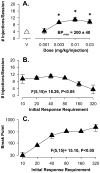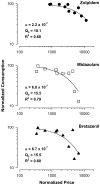Self-administration of bretazenil under progressive-ratio schedules: behavioral economic analysis of the role intrinsic efficacy plays in the reinforcing effects of benzodiazepines
- PMID: 20800977
- PMCID: PMC3025040
- DOI: 10.1016/j.drugalcdep.2010.07.019
Self-administration of bretazenil under progressive-ratio schedules: behavioral economic analysis of the role intrinsic efficacy plays in the reinforcing effects of benzodiazepines
Abstract
Previous research suggests that intrinsic efficacy of benzodiazepines is an important determinant of their behavioral effects. We evaluated the reinforcing effects of the benzodiazepine partial agonist bretazenil using behavioral economic models referred to as "consumer demand" and "labor supply". Four rhesus monkeys were trained under a progressive-ratio (PR) schedule of i.v. midazolam injection. A range of doses of bretazenil (0.001-0.03 mg/kg/injection and vehicle) was evaluated for self-administration with an initial response requirement of 40 that doubled to 640; significant self-administration was maintained at doses of 0.003-0.03 mg/kg/injection. Next, a dose of bretazenil that maintained peak injections/session was made available with initial response requirements doubling from 10 to 320 (maximum possible response requirements of 160 and 5120, respectively), and increasing response requirements decreased self-administration (mean number of injections/session) of a peak dose (0.01 mg/kg/injection). Analyses based on consumer demand revealed that a measure of reinforcing strength termed "essential value", for bretazenil was similar to that previously obtained with midazolam (non-selective full agonist), but less than that observed for zolpidem (full agonist, selective for α1 subunit-containing GABA(A) receptors). According to labor supply analysis, the reinforcing effects of bretazenil were influenced by the economic concept referred to as a "price effect", similar to our previous findings with midazolam but not zolpidem. In general, behavioral economic indicators of reinforcing effectiveness did not differentiate bretazenil from a non-selective full agonist. These findings raise the possibility that degree of intrinsic efficacy of a benzodiazepine agonist may not be predictive of relative reinforcing effectiveness.
Copyright © 2010 Elsevier Ireland Ltd. All rights reserved.
Figures



Similar articles
-
Reinforcing effects of compounds lacking intrinsic efficacy at α1 subunit-containing GABAA receptor subtypes in midazolam- but not cocaine-experienced rhesus monkeys.Neuropsychopharmacology. 2013 May;38(6):1006-14. doi: 10.1038/npp.2012.265. Epub 2012 Dec 27. Neuropsychopharmacology. 2013. PMID: 23303046 Free PMC article.
-
Comparison of zolpidem and midazolam self-administration under progressive-ratio schedules: consumer demand and labor supply analyses.Exp Clin Psychopharmacol. 2007 Aug;15(4):328-37. doi: 10.1037/1064-1297.15.4.328. Exp Clin Psychopharmacol. 2007. PMID: 17696679
-
Self-administration of progesterone and synthetic neuroactive steroids by male rhesus monkeys.Drug Alcohol Depend. 2016 Aug 1;165:265-9. doi: 10.1016/j.drugalcdep.2016.05.029. Epub 2016 Jun 8. Drug Alcohol Depend. 2016. PMID: 27302854 Free PMC article.
-
Differential behavioral effects of low efficacy positive GABAA modulators in combination with benzodiazepines and a neuroactive steroid in rhesus monkeys.Br J Pharmacol. 2006 Feb;147(3):260-8. doi: 10.1038/sj.bjp.0706550. Br J Pharmacol. 2006. PMID: 16331290 Free PMC article.
-
Evaluation of the anti-conflict, reinforcing, and sedative effects of YT-III-31, a ligand functionally selective for α3 subunit-containing GABAA receptors.J Psychopharmacol. 2020 Mar;34(3):348-357. doi: 10.1177/0269881119882803. Epub 2019 Oct 31. J Psychopharmacol. 2020. PMID: 31670615 Free PMC article.
Cited by
-
Intracranial self-stimulation to evaluate abuse potential of drugs.Pharmacol Rev. 2014 Jul;66(3):869-917. doi: 10.1124/pr.112.007419. Pharmacol Rev. 2014. PMID: 24973197 Free PMC article. Review.
-
The behavioral pharmacology of zolpidem: evidence for the functional significance of α1-containing GABA(A) receptors.Psychopharmacology (Berl). 2014 May;231(9):1865-96. doi: 10.1007/s00213-014-3457-x. Epub 2014 Feb 22. Psychopharmacology (Berl). 2014. PMID: 24563183 Review.
-
Abuse-related effects of subtype-selective GABAA receptor positive allosteric modulators in an assay of intracranial self-stimulation in rats.Psychopharmacology (Berl). 2017 Jul;234(14):2091-2101. doi: 10.1007/s00213-017-4615-8. Epub 2017 Apr 1. Psychopharmacology (Berl). 2017. PMID: 28365836 Free PMC article.
-
Reinforcing effects of compounds lacking intrinsic efficacy at α1 subunit-containing GABAA receptor subtypes in midazolam- but not cocaine-experienced rhesus monkeys.Neuropsychopharmacology. 2013 May;38(6):1006-14. doi: 10.1038/npp.2012.265. Epub 2012 Dec 27. Neuropsychopharmacology. 2013. PMID: 23303046 Free PMC article.
-
Anhedonia modulates benzodiazepine and opioid demand among persons in treatment for opioid use disorder.Front Psychiatry. 2023 Jan 19;14:1103739. doi: 10.3389/fpsyt.2023.1103739. eCollection 2023. Front Psychiatry. 2023. PMID: 36741122 Free PMC article.
References
-
- Allison J. Behavioral Economics. Praeger Publishers; New York: 1983.
-
- Allison J, Boulter P. Wage rate, nonlabor income, and labor supply in rats. Learn Motiv. 1982;13:324–42.
-
- Ator NA. High-dose discrimination training with midazolam: context determines generalization profile. Pharmacol Biochem Behav. 1999;64:237–43. - PubMed
-
- Ator NA. Relation between discriminative and reinforcing effects of midazolam, pentobarbital, chlordiazepoxide, zolpidem, and imidazenil in baboons. Psychopharmacology. 2002;163:477–87. - PubMed
Publication types
MeSH terms
Substances
Grants and funding
LinkOut - more resources
Full Text Sources
Research Materials

